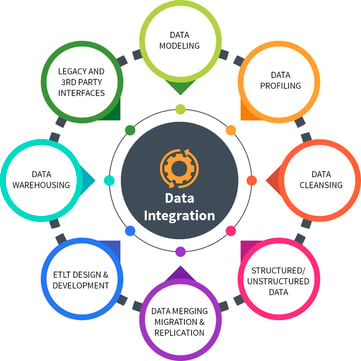5 Top Reasons for HR Data Integration
If you’re leading a Human Resources team and feel swamped by all the data streams coming at you, you’re not alone.
Every day, it seems, there’s a new app or cloud-based system that promises to make work easier. But what happens when all those apps start breeding like rabbits throughout the business? Different kinds of data streams start popping up all over the place, and they won’t always be able to talk to each other or you.
How can you harness the power of data instead of letting it overwhelm you?
Data integration can help you. Data integration means taking data from many different sources and combining it to achieve a single, verified, unified view. It can also mean point-to-point integration, moving data from one source to another app. or data repository.
Of course, there are several ways you could do this. But once the data is solid, accurate, and accessible from a single source of truth, you can tap into correct information whenever you need it.
Easily accessible, accurate data means better insight into what’s going on in your operations.
If you’re in a large company using an Enterprise Resource Planning (ERP) system, you have already integrated your core business apps and processes. But what if your firm is smaller and doesn’t have the budget—or the need—for all the bells and whistles?
Rather than buying an expensive new system, you can integrate what you already have. You can decide what’s most important to connect, then engage an integrator to make it happen.
Data integration will become especially important if you want to better manage your talent in the future, says HR industry analyst Josh Bersin.
Bersin says a big trend for HR Tech in 2022 will be skilled taxonomies: defining and measuring workforce skills and organizing them into a centralized database.
You can use a skills database to do many useful things, like developing a better process for employee assessments. So far, however, there’s no such thing as an “integrated skills platform.”
That means you’ll need to integrate lots of third-party data to build good skills engines for your business. And integration is key to that. 
Here are five top reasons you should use data integration tools:
1. Better access and speed
Data integration makes information more accessible, so more people in your organization can get the data they need. It also speeds up how fast they can get it—no more waiting for departmental approvals or manual data conversions.
Firms are moving away from data silos (raw data stored on a server, controlled by one department). Instead, you’ll see more on-demand, cloud-based integrated systems based on a shared pool of connected data.
This immediately helps your employees and managers who need the latest data to do their work.
2. Accurate data—no human error
Not all data is good data. A June 2018 Gartner article on “How to Build a Business Case for Data Quality Improvement” reported that organizations believed poor data quality was causing $15 million per year in losses.
Bad data include missing data, wrong information, duplicate entries, spelling variations, incorrect formats, typos, and other inaccuracies. These things waste time.
Bad data can lead to incorrect customer assumptions, costly business mistakes, and delayed or bad decisions.
Data integration eliminates problems of human error. Automating the data flows will get more accurate facts and figures.
You’ll also benefit from analytics tools to help you drill down to what’s happening in different work areas.
3. More efficient processes and workflows
Even before the pandemic, a 2019 Martech report noted that “the average company with 200 to 500 employees uses about 123 software-as-a-service (SaaS) applications.” And some departments change their apps frequently.
The pandemic pushed these figures up.
That’s a whole lot of apps—with a greater chance some will be incompatible with each other and with the HR system of record.
Data integration will help you reconcile data from many disparate apps and systems. It gives you and your staff a more consistent, reliable data flow.
4. Better candidate experiences
Integrated data will help you improve marketing and deliver a more seamless recruiting candidate experience.
Even the most experienced and creative recruiter still needs robust data to guide them—specific, accurate and unified. According to Forrester & Google, the No. 1 factor preventing marketers from capturing a complete view of their marketing and media campaign is the lack of integration of their marketing analytics tools.
Integrated data connections help you create a better experience, leading to more good hires and lower new hire attrition.
5. Better adaptability for the future
Imagine changing your business plan or even the way you perform a specific task, triggered by new information at your fingertips. Data integration can help you do that.
You can leverage your data to new, unanticipated uses that might even save your business one day.
The pandemic is a case in point. It forced firms to speed up the development of their shared remote tools and systems to function online and talk to employees working from home.
People quickly realized that they needed better tools to communicate well via computer screens, mobile phones, or tablets.
We expect enhanced technology for better collaboration in 2022 to support hybrid work and better teamwork. And it will depend on better integration of many kinds of data.
Integration can help you better adapt to a changing future.
Future drivers of success
Haighton-Williams, writing in the HR Executive, points to three key drivers of success for the new era of work:
- the successful integration of third-party tools,
- tools and infrastructure to support cross-team value streams, and
- the introduction of more visual collaboration tools and increased workflow.
Your workers, colleagues, and executives will soon be expecting access to multiple data streams.
They will want to report to their managers more efficiently, collaborate with teams on projects, book vacation time, seek advice from mentors, or even learn new job-related skills—all in the flow of their typical workday.
And they’d be able to do this from any device, wherever they are, just by using the correct online system, employee website, or digital app.
This kind of technological agility is a fundamental challenge facing many organizations. Many companies are at very different stages of this journey.
But you don’t have to do it all at once. Data integration is the right place to start.
You need to connect to your data wherever it lives, wherever your staff may be.
About Pixentia
Pixentia is a full-service technology company dedicated to helping clients solve business problems, improve the capability of their people, and achieve better results.


